Author: Joel John Source: Decentralised.co Translation: Shan Ouba, Golden Finance
The killer application of the crypto world has emerged in the form of stablecoins. In 2023, Visa's transaction volume was close to $15 trillion, while the total transaction volume of stablecoins was about $20.8 trillion. Since 2019, the total transaction volume of stablecoins between different wallets has reached $221 trillion.
In the past few years, capital equivalent to the global GDP has flowed in our blockchain. Over time, this capital has accumulated in different networks. Users switch between different protocols in search of better financial opportunities or lower transfer fees. With the advent of chain abstraction, users may not even realize that they are using a cross-chain bridge.
Cross-chain bridges can be thought of as routers for funds. When you visit any website on the Internet, there is a complex network behind it that ensures that the data is presented accurately. In this network, the physical router in your home is crucial, determining how data packets should be directed to help you get the data you need in the shortest time.
Today, cross-chain bridges play this role in on-chain funds. When a user wants to transfer funds from one blockchain to another, the cross-chain bridge determines how to route the funds to ensure that the user gets the most value or speed when the funds are transferred.
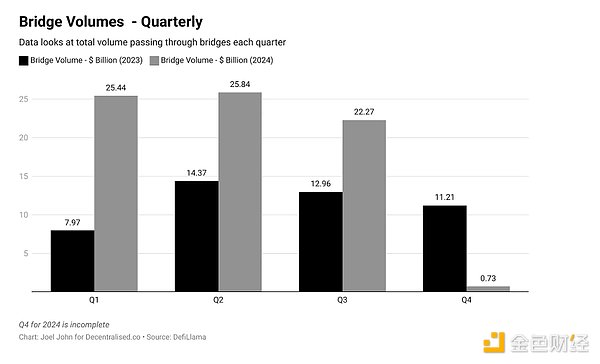
Since 2022, cross-chain bridges have processed nearly $22.27 billion. This amount is far from the funds that flow on the chain through stablecoins. However, Cross-Block Bridge appears to generate higher profits per user and per unit of locked capital than many other protocols.
Today’s article is a collaborative exploration of the business model behind Cross-Block Bridge and the revenue it generates through bridged transactions.
Showing Profit
Since mid-2020, Cross-Block Bridge has generated nearly $104 million in cumulative fees. This amount has some seasonal fluctuations as users tend to flock to bridge platforms to use new applications or pursue economic opportunities. If there are no yields, meme tokens, or financial primitives available, the use of bridge platforms will decrease and users will tend to use the protocols they are most familiar with. A sad (but amusing) comparison is to compare bridge inflows to memecoin platforms like PumpFun. PumpFun generated $70 million in fees, while the cross-chain bridge generated only $13.8 million in fee revenue. The reason fees have remained flat even as transaction volume has risen is the ongoing price war between chains. To understand how this efficiency is achieved, it is necessary to understand how most bridge platforms work. One model for understanding cross-chain bridges is to compare them to the Hawala network of a century ago.
A blockchain bridge is similar to the hawala network, which bridges physical separations through cryptographic signatures.
Although hawala is more associated with money laundering today, a century ago it was an efficient way to transfer funds. For example, if you wanted to transfer $1,000 from Dubai to Bangalore in the 1940s, when the Indian rupee was still used in the UAE, you had a few options.
You could use a bank, which could take days and require a lot of documentation, or you could go to Dubai's gold souk. The souk's vendor would accept your $1,000 and instruct the merchant in India to pay the equivalent amount to your trusted person in Bangalore. The money would change hands between India and Dubai, but it would not actually cross the border.
This model relies on trust between the vendor and the Indian merchant, similar to how a cross-chain bridge works. Instead of moving funds directly, the two parties might settle their balances through a commodity, such as gold. Because these transactions rely on mutual trust between individuals, it requires a lot of confidence on both sides to be honest and cooperate.
How Bridge Platforms Work
Bridge platforms operate in a similar way in many ways. For example, you might want to move funds from Ethereum to Solana in pursuit of yield. Bridge platforms like LayerZero help users borrow and lend on one chain and stake on another, doing so by passing messages between users.
Let’s say that instead of using bars of gold, two traders give you a code that can be exchanged for capital in either place. This code is a way to pass messages. LayerZero uses what are called endpoints, which are smart contracts that exist on different chains. A smart contract on the Solana chain may not understand a transaction on the Ethereum chain, which is where oracles come into play. LayerZero uses Google Cloud as a validator for cross-chain transactions. Even on the cutting edge of Web3, we still rely on Web2 giants to help build a better economy.
For traders who don't trust the ability of code to interpret, another way is through locking and minting assets. For example, your assets on Ethereum can be locked through the Wormhole bridge platform to obtain a wrapped asset on Solana. This is similar to a hawala vendor giving you a gold bar in India in exchange for your US dollar deposit in the UAE. As long as you return the gold bar, you can get your original funds back in Dubai. Wrapped assets on different chains are similar to gold bars, the only difference is that their value on both chains is usually the same.
The figure below shows all the variants of Bitcoin today. Most of them were minted during the DeFi summer to create yield on Ethereum using Bitcoin.

Bridges have several key points where they can make money:
TVL - When users come to deposit funds, these funds can be used to generate yield. Today, most bridges do not absorb idle capital and lend it out, but instead charge a small transaction fee when users transfer capital from one chain to another.
Relay fees - These are third parties (such as Google Cloud in Layer Zero) that charge a small fee for a single transfer. This fee is used to verify transactions on multiple chains.
Liquidity Provider Fees - This is the money paid to the individual who deposits funds into the bridge smart contract. Let's say you are running a hawala network and now someone is transferring $100 million from one chain to another. You personally may not have that much funds. Liquidity providers are individuals who pool these funds to help facilitate the transaction. In return, each liquidity provider gets a small share of the fees generated.
Minting Costs - A bridge can charge a small fee when it mints an asset. For example, WBTC charges a fee of 10 basis points for each Bitcoin
Of these, the bridge's fees go to maintaining the relayer and paying liquidity providers. It creates value for itself in TVL through transaction fees and assets minted by both parties to the transaction. Some bridges also have an incentivized staking model. Let's say you are making a $100 million hawala transfer to someone across the ocean. You may need some form of economic guarantee that the person on the other side is getting value for money.
He might be willing to call up his friends in Dubai and pool their capital to prove to you that he’s worth your money. In exchange, he might even give back some of his fees. That’s how staking is structured. Except instead of staking dollars, users come together to give the network’s native tokens in exchange for more tokens.
But how much money is all this bringing in? What is the value of these products per dollar or per user?
Economics
The data below is a little messy because not all fees go to the protocol. Sometimes the fees depend on the protocol and the assets involved. It can also result in users incurring slippage if the bridge is primarily used for long-tail assets with low liquidity. So as we look at unit economics, I want to make it clear that the following is not a reflection of which bridges are better than others. We are interested in looking at how much value is generated across the supply chain during the bridging event.
A good place to start is by looking at 90-day volumes and fees generated across protocols. The data looks at metrics through August 2024, so these numbers are for the next 90 days. We assume Across has higher volumes because it has lower fees.
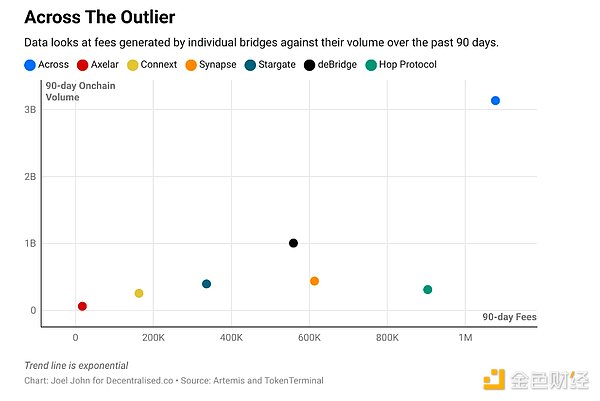
This gives a rough idea of how much money flows through the bridges in a given quarter, and the types of fees they incur during the same period. We can use this data to calculate the amount of fees a bridge generates for every dollar that flows through its system.
For ease of reading, I calculated the data as the fees incurred for moving $10,000 through these bridges.
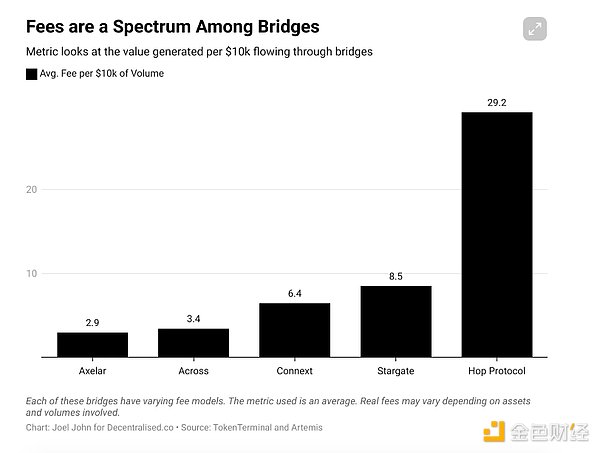
Before we start, I want to clarify that this does not mean that Hop charges ten times more than Axelar. Rather, it means that every $10,000 transfer on a bridge like Hop can create $29.2 in value across the value chain (for LPs, relayers, etc.). These metrics are different because of the different nature and types of transfers they support. The most interesting part for us is when we compare it to the value captured on the protocol and the value of the bridge.
For benchmarking purposes, we looked at the cost of a transaction on Ethereum. As of the time of writing, with lower gas fees, a transaction costs about $0.0009179 on ETH and about $0.0000193 on Solana. Comparing a bridge to an L1 is a bit like comparing a router to a computer. The cost of storing a file on a computer is going to be exponentially lower. But the question we’re trying to address here is whether a bridge captures more value than an L1 from an investment objective perspective.
From this perspective, and in comparison to the metrics above, one way to compare the two is to look at the USD fees charged per transaction by the various bridges and contrast that to Ethereum and Solana.
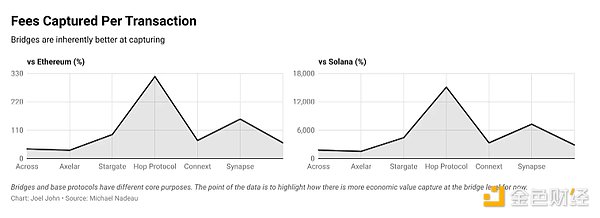
The reason why many cross-chain bridges have lower fees than Ethereum is because of the high gas fees incurred when performing cross-chain transactions on Ethereum.
One might argue that the economic value captured by the Hop protocol is 120 times that of Solana. But this misses a key point, as the fee models of the two networks are very different. We focus on the difference between economic value capture and valuation, which will become apparent soon.
Of the top seven cross-chain bridges, five have lower fees than Ethereum L1. Axelar is the cheapest, with fees of just 32% of the average Ethereum fees over the past 90 days. Hop Protocol and Synapse currently have higher fees than Ethereum. Compared to Solana, L1 settlement fees on high-throughput chains are much cheaper than current cross-chain bridge protocols.
One way to further enhance this data is to compare L2 transaction fees in the EVM ecosystem. For context, Solana’s fees are 2% of Ethereum’s. For this comparison, we will choose Arbitrum and Base. L2 is designed for extremely low fees, so we will use a different metric to measure economic value - namely, daily average fees per active user.
In the 90 days we collected data for this article, Arbitrum had an average of 581,000 daily users and generated $82,000 in fees per day. Base had an average of 564,000 daily users and generated $120,000 in fees per day.
Bridges, by contrast, have far fewer users and far fewer fees. The highest of these is Across, which has 4,400 users and generates $12,000 in fees per day. From this, we estimate that Across creates $2.4 in value per user per day. This metric can be compared to the fees generated per active user by Arbitrum or Base to assess the economic value of each user.
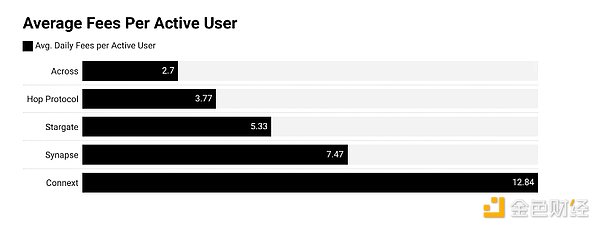
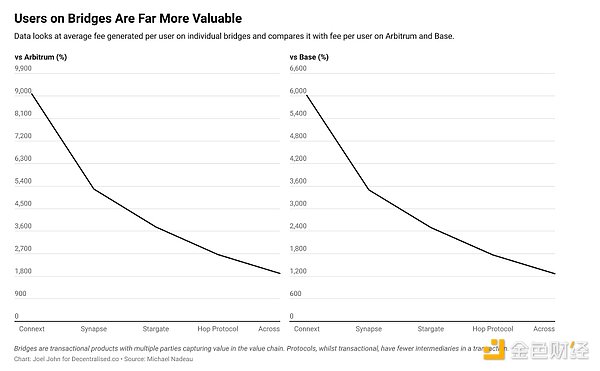
Currently, the average user of the cross-chain bridge is more valuable than the user of L2. The average user of Connext creates 90 times the value of the Arbitrum user. While this is a bit like comparing “apples and oranges” because of the higher gas fees associated with cross-chain transactions on Ethereum, it highlights two clear factors.
Here, I avoid comparing fees or revenues. I am more interested in the velocity of capital. It can be defined as the number of times money moves between smart contracts on a cross-chain bridge or a decentralized exchange. To calculate this velocity, I divide the daily trading volume of cross-chain bridges and decentralized exchanges by their total value locked (TVL).
As expected, the velocity of funds on decentralized exchanges is much higher because users typically swap assets back and forth multiple times a day.
However, it is interesting to note that when we exclude L2 cross-chain bridges like Arbitrum or Optimism, the velocity of funds on cross-chain bridges is not much different from that of decentralized exchanges.
Perhaps in the future, we will see some cross-chain bridges limit the amount of capital they accept and instead maximize returns by increasing the speed of capital turnover. That is, if a cross-chain bridge can turn over funds multiple times a day and spread the fees among a small number of users who deposit funds, it will be able to generate higher returns than other sources in the current crypto market.
Such a cross-chain bridge may have a more stable TVL than traditional cross-chain bridges, where the returns decrease as the scale of deposited funds increases.
Fund routers like cross-chain bridges may be one of the few product categories in the crypto industry that can create significant economic value.
As long as transaction fees remain high, we may not see users flock to L1s like Ethereum or Bitcoin. Instead, users may be directed directly to L2s (such as Base), and developers may choose to cover gas costs for users. Or, users may only switch between low-cost networks.
Another way to compare the economic value of a cross-chain bridge is to compare it to a decentralized exchange. The two are similar in function: decentralized exchanges allow conversions between different assets, while cross-chain bridges transfer assets between different blockchains.

Is a cross-chain bridge a router? If you think the VC rush to “infrastructure” is a new phenomenon, let’s take a look back. In the 2000s, when I was very young, the Silicon Valley favorite was Cisco. The logic was that as data traffic through the Internet pipes increased, routers would capture a lot of value. Just like NVIDIA today, Cisco’s stock was highly valued as a company that built the Internet’s physical infrastructure. Cisco’s stock peaked at $80 on March 24, 2000, and at the time of writing, it’s trading at $52. Unlike many dot-com stocks, Cisco never fully recovered to its peak levels. In the current memecoin frenzy, it got me thinking whether cross-chain bridges can capture the same value. Cross-chain bridges have network effects, but they are likely a "winner-takes-all" market that is gradually moving to an intent and solver mechanism, with centralized market makers filling orders in the background. Ultimately, most users don't care about the degree of decentralization of the cross-chain bridge they use. They care about cost and speed.
In such a world, early cross-chain bridges may be similar to physical routers that are close to being replaced, and in the future may be replaced by technologies like intent or solver networks, similar to the role of 3G for the Internet.
Cross-chain bridges have reached a stage of maturity, and we now see multiple solutions trying to solve the same problem of cross-chain asset transfer. A big driver of this change is chain abstraction, where assets can move between blockchains without the user even realizing it. Shlok recently tried out Particle Network’s Universal Account, demonstrating this seamless asset transfer experience.
Another driver of volume growth is innovation in how products are distributed or positioned. Last night, while exploring Memecoin, I noticed that IntentX is using intents to package Binance’s perpetual contract market as a decentralized exchange product. We’re also seeing some chain-specific cross-chain bridges become more competitive.
Whatever the approach, it’s clear that, like decentralized exchanges, cross-chain bridges are hubs for large capital flows. As an infrastructure, they are here to stay and grow. We believe that domain-specific cross-chain bridges (such as IntentX) or user-specific cross-chain bridges (such as cross-chain bridges achieved through chain abstraction) will become the main driving force for growth in this field.
Shlok made an interesting point when discussing this article: Routers in the past transmitted a lot of data, but the economic value they captured was not proportional to the amount of data transmitted. Whether you download 1TB or 1GB, Cisco makes about the same money. Cross-chain bridges are different. They make money based on the number of transactions they facilitate. Therefore, cross-chain bridges and routers may have different fates.
What is certain at present is that the current situation of cross-chain bridges has similarities to the story of the physical infrastructure that routed Internet data in the past.
 Anais
Anais











